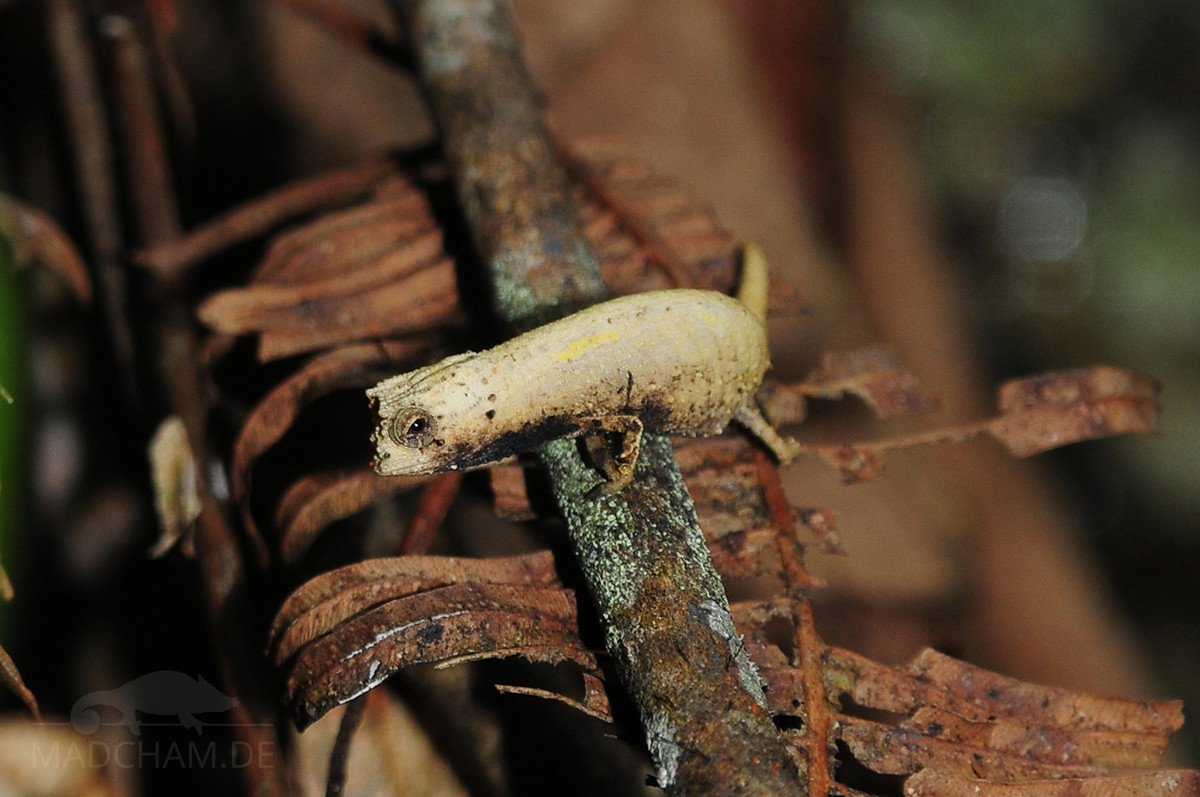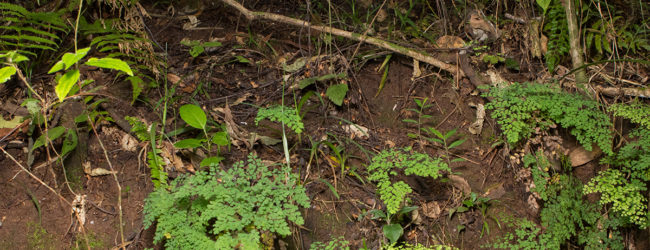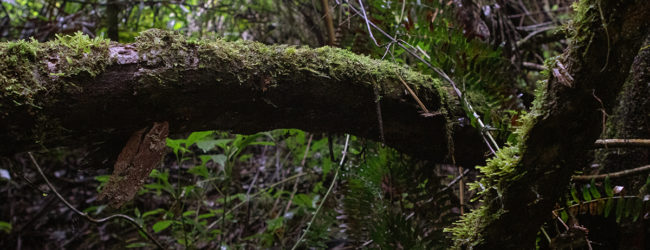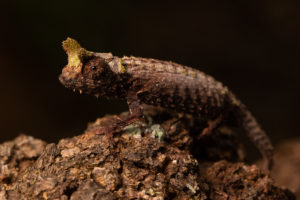no legal export possible
First description:
Origin of the species name:
Édouard-Raoul Brygoo (later working at the Natural History Museum in Paris, France) and Charles Antoine Domergue of the then Institut Pasteur in Antananarivo, Madagascar dedicated this chameleon species to the zoologist Guy Ramanantsoa. Ramanantsoa worked at the University of Antananarivo and also dealt with chameleons at times. He had described the species Calumma ambreense a year earlier.
Distribution:
Brookesia ramanantsoai can be found in the eastern highlands of Madagascar. Originally these small chameleons are known from the Andasibe-Mantadia National Park, but we have never been able to observe them there. However, only 25 km east of Andasibe is the Vohimana reserve. There you have much better chances to spot Brookesia ramanantsoai. Also west of Andasibe, in some small forest patches near Mandraka, the species is resident. Not far from Mandraka is Lake Mantasoa, near where the species was first found. The entire distribution range of Brookesia ramanantsoai is relatively high, at about 1000 to 1300 m above sea level.
Appearance and size:
Brookesia ramanantsoai belongs to the minima group and is accordingly small. From the tip of the nose to the tail it measures just 41 to 44 mm. Instead of a pelvic shield, they carry only two pelvic spines. In the anterior half of the body, there are two better developed latero-vertebral tubercles, the others are barely developed. Purely visually, the species is indistinguishable from Brookesia dentata, but research is still lacking here. Genetically the two species are different and also occur in two completely different habitats.
| Jan | Feb | Mar | Apr | May | Jun | Jul | Aug | Sep | Oct | Nov | Dec | |
| Average temperature | 23 | 24 | 23 | 24 | 21 | 19 | 19 | 19 | 20 | 21 | 22 | 23 |
| Minimum temperature | 20 | 20 | 20 | 19 | 18 | 15 | 15 | 15 | 15 | 16 | 18 | 19 |
| Maximum temperature | 27 | 27 | 27 | 27 | 25 | 23 | 23 | 23 | 24 | 25 | 26 | 27 |
| Rain days | 27 | 24 | 26 | 19 | 17 | 18 | 21 | 20 | 15 | 16 | 20 | 25 |
We have collected the data given above over several years with thermometers and hygrometers at the finding places of the chameleons. "Average temperature" means that values of a whole month have been calculated to one average value per month. For example all measured minimum temperature values of February have been calculated to one average minimum temperature for February. In plain language, this means single peak values of a day may be a little higher or lower than the average minimum and maximum temperatures. It is possible that a location has an average maximum temperature of 29°C, but one day during that month it had 33°C or even 35°C there.
Examples of daily patterns of temperatures in Vohimana during the rainy season can be found below. They were recorded in 2023/24 with data loggers.

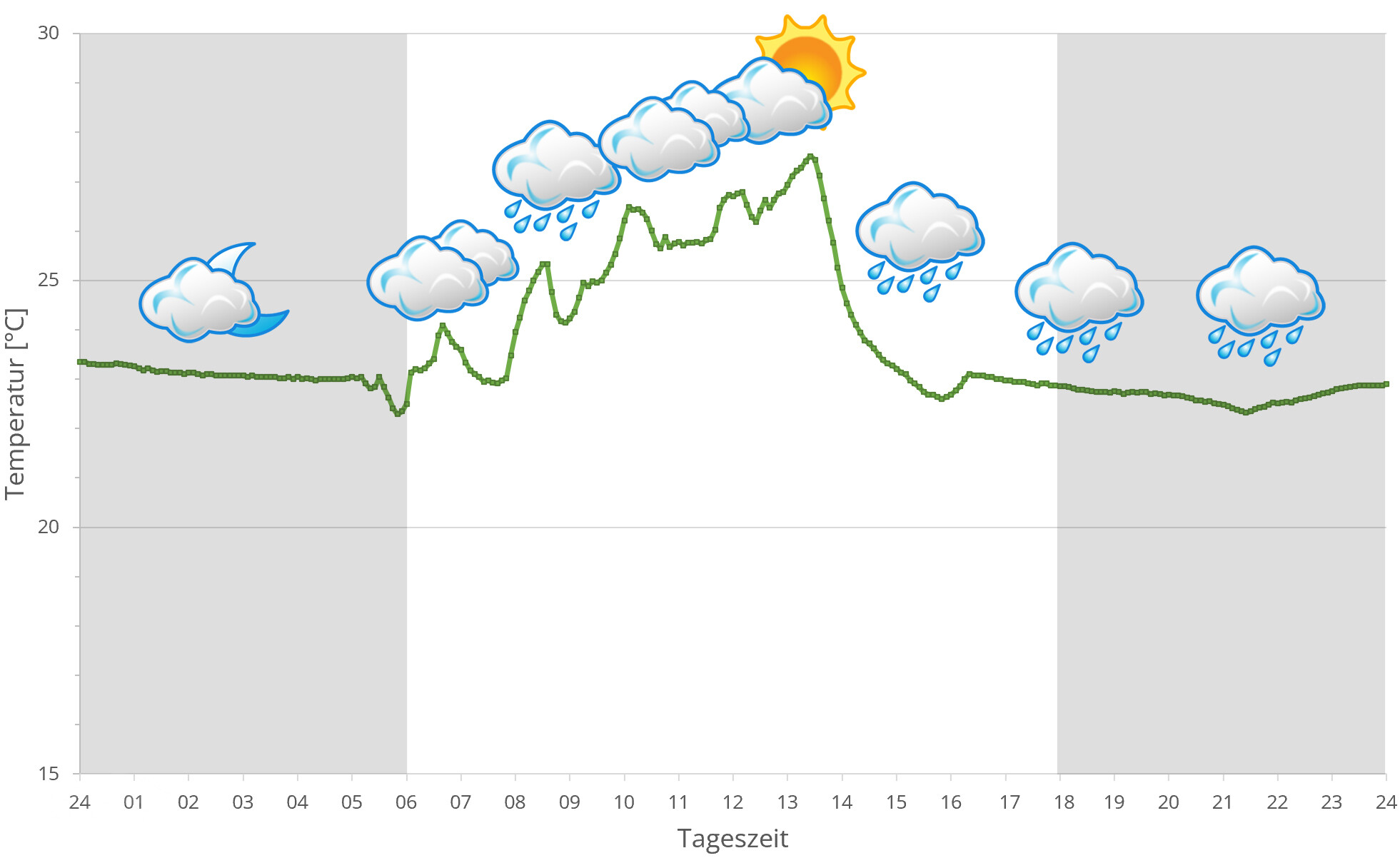
Climate in Vohimana is comparable to region Andasibe-Mantadia. It is also located in eastern highlands on eleveations about 1000 m above sea level. Accordingly, nights can become rather cool with temperatures around 15°C.
During rainy season, it rains daily and intensively. Temperatures reach 25 to 28°C during daytime, in sunny places a little more. In dry season, temperatures are lower and it does not rain daily but still regularly. In 2023/24, we measured relative humidity with data loggers on several days in Vohimana during the rainy season, the data can be found below.



 Tageszeit = day time, Sonne = sun, Halbschatten = half shade, Schatten = shade
Tageszeit = day time, Sonne = sun, Halbschatten = half shade, Schatten = shade
We have measured UVB data with a Solarmeter 6.5 in spring (beginning of April) at the peak of activity of chameleons in Madagascar. We always measured the values that a chameleon could maximally reach in its habitat.
In 2023, in addition to other climate data, we also measured the air pressure at the locations we visited in Madagascar. The following data is from a full day during the rainy season in Vohimana. On the X-axis is the time of day or night. In Madagascar, the day begins around 6 am and night falls at 6 pm. TheY axis shows the atmospheric pressure in hPa.


Habitat:
The following photos show sections of the habitat of Brookesia ramanantsoai during the rainy season in a small reserve near Mandraka. Both in Vohimana and near Mandraka the chameleons tend to occur on slopes. Delicate, small plants and many ferns grow. Leaves and deadwood cover the ground but do not form as thick a layer as in other parts of the forest. For roosting, Brookesia ramanantsoai often seek out the higher, wide, mossy roots of large trees, like other leaf chameleons of the minima group.
Below you will find some 360° images from Vohimana and Saha Maintsoanala that we took during the rainy season. If you click on the respective image, the pictures will open in an enlarged view in a separate window. You can use the mouse to rotate in all directions. You also have the option of running the images in full-screen mode. Enjoy!

